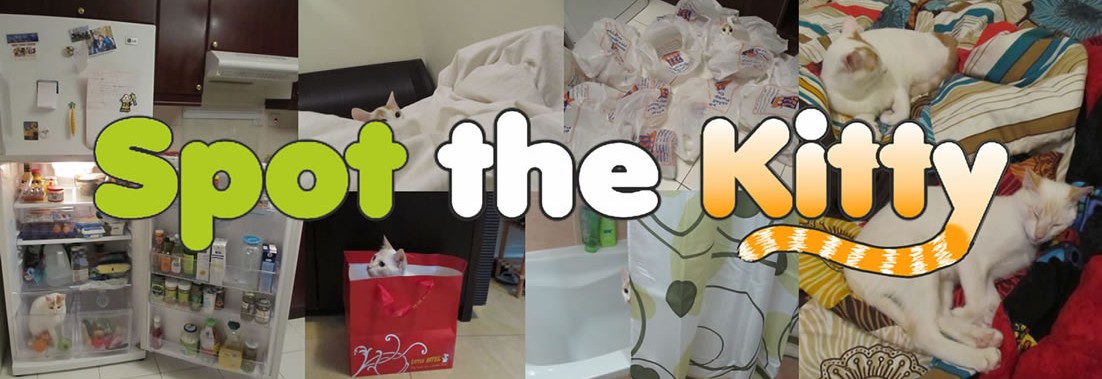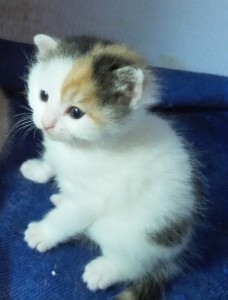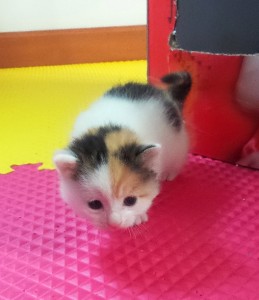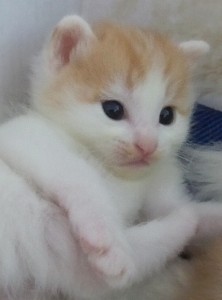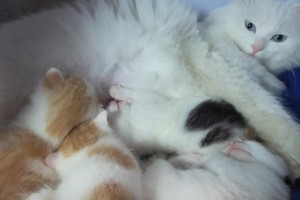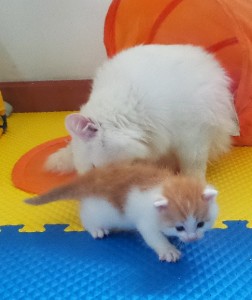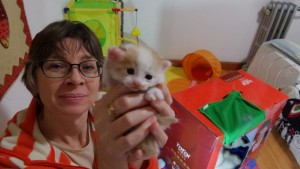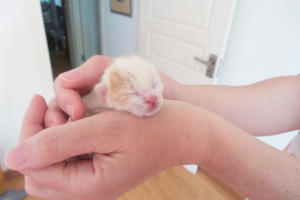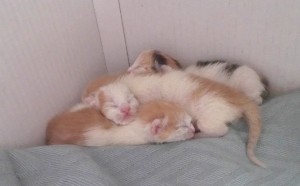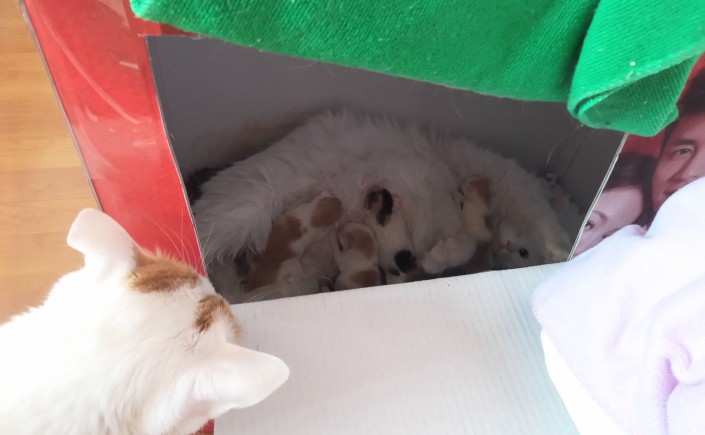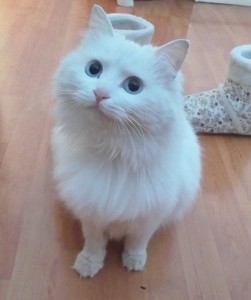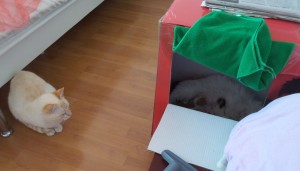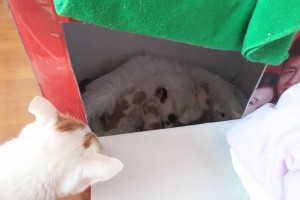Kitty Delivery
As your kitty is getting close to her delivery day, she is sharing her excitement with you by being extra affectionate. Lots of lap-sitting, purring, and following you around. She might also get more vocal. Just go with it. She will need your love and reassurance, and she is not going to shout obscenities at you like your mother probably did at your dad, so this delivery is something to look forward to.
Advertisement: Click here to play Spot the Kitty
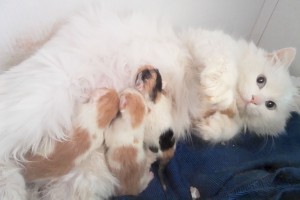
Here Libby proudly shows off her newborn kittens. There are four of them. The fourth one is playing Spot the Kitty. Can you find her?
Make sure she has a comfortable place to deliver her kittens. If you build a kittening box for her, you should cut a doorway that is low enough for her to get in and out easily but not low enough for kittens to climb out. About three inches from the floor is a good kittening-box door height. The delivery process is messy, so make sure you line the bed with old t-shirts or towels that you don’t mind throwing away. Wash them with natural detergent first to get any scents out of them, and don’t use any fabric softener or dryer sheets. Your cat won’t want to deliver her babies in a nest that smells of perfume or other animals, and a strong scent can also confuse the new kittens and prevent them from finding their mother’s nommy nipples.
As you get close to delivery day, take your pregnant cat to the vet. The vet will make sure that the pregnancy is progressing nicely and give you some advice for the delivery. If your cat has any health problems, tell your vet so she can advise you how best to proceed.
Most vet-grade pet food companies will produce a “mother and kitten” cat food. This is the best for your mommy cat’s health and the health of the growing kittens, and you should start to feed it to her about half-way through her pregnancy.
If you work full time or go to school, you might not be present for delivery day. I checked Libby every day when I got home from work and sat with her all day Saturday when she was supposed to be getting close to her delivery day, but nothing. Then on Sunday morning I checked on her to find her in her kittening box with a litter of four clean, fluffy kittens having their breakfast.
Libby was lucky, but not all cats have the natural instincts for giving birth or caring for their new kittens, especially if it is their first time. Also, some cats might develop medical problems or complications. Keep a close eye on your kitty as you get close to her delivery day, and if you notice any vaginal discharge or signs of illness, take her back to the vet.
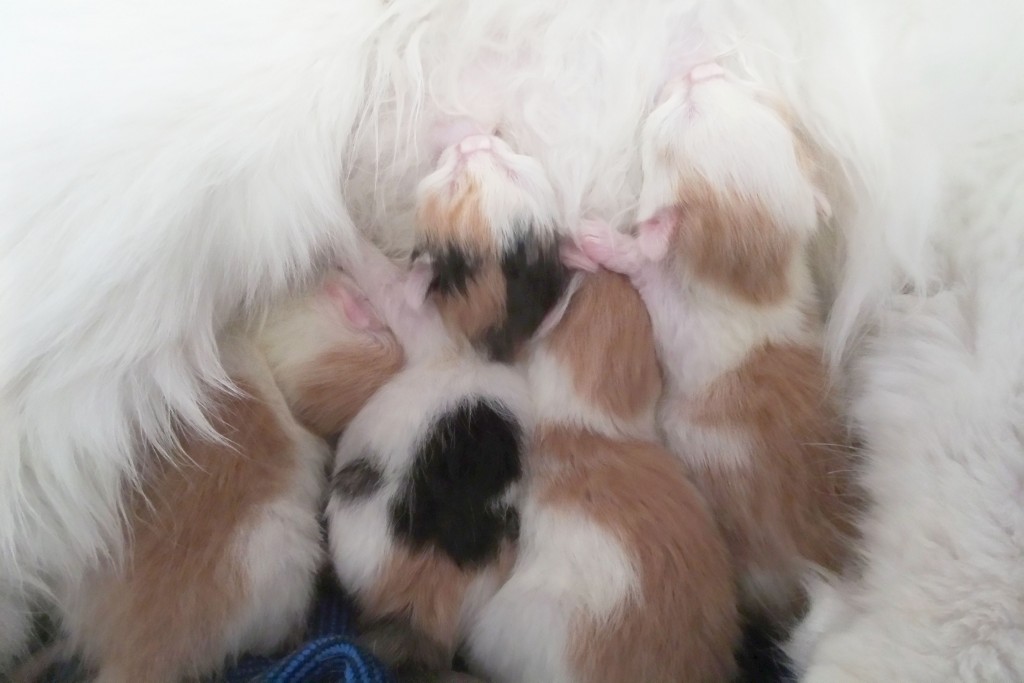
Here’s a close-up of the four babies suckling. It’s their first meal!
Labour
You will notice your cat is going into labour when she:
- Starts pacing around the house
- Pants, meows or purrs more loudly than usual
- Licks herself a lot more than usual, especially in the vaginal area
- Stops eating
- Hides
- Vomits
Labour can last for up to 24 hours. If it seems to be going on for too long, or if your kitty starts to bleed before giving birth, take her to the vet.
Preparing for Delivery
If you are present for your kitty’s big day, there are a few things you should be ready to help with.
- First, as well as a box, get a few things prepared:
- a very soft washcloth, in case you need to help her clean off her kittens
- your vet’s number in case you need advice or have a problem during the birth
- your cat carrier, in case you need to rush your cat to the vet
- a kitten bottle and kitten formula, in case you need to help her feed the kittens
- Wash your hands thoroughly and remove any sharp jewelry, just in case you need to help.
- Stay nearby so you can keep an eye on proceedings and reassure your cat, but don’t hover.
Cats have contractions just as humans do. You will know a kitten is coming when the contractions are about two or three minutes apart.
You should see the amniotic sac come out; it looks like a thin, clear sac filled with fluid. The kitten will be inside. Kittens usually come out head first or rear paws first. Kittens are born one at a time with twenty to thirty minutes between each kitten. Each kitten is followed by a placenta.
Once a kitten emerges, your cat should lick the amniotic sac and fluid off the kitten’s face, which stimulates breathing. You might hear the kitten make tiny mews. Your cat will likely eat the placenta and lick the rest of the amniotic sac off the kitten as she waits for the next birth.
Problems
- The mother might not lick off her kitten’s face immediately, especially the first kitten. If she doesn’t lick the sac off the kitten’s nose and mouth within a few seconds of birth, the kitten will asphyxiate and die. In this case, you should gently pick up the kitten, being sure to support its head, and use the soft washcloth to gently wipe the amniotic sac off the nose and mouth. Then give the kitten back to the mother and she will likely take over.
- The mother might not pay attention to the first kitten after it is born, even if you clean the kitten’s nose and mouth. In this case, gently pick up the kitten again and use the soft washcloth to clean the amniotic sac and fluid off the entire kitten. This should cause the kitten to start crying, which will probably get the mother’s interest.
- Although your cat will probably eat the placenta, keep a placenta count. Each kitten should be followed by one placenta. If you suspect that a placenta has not come out, take your cat to the vet. It is important that she eliminate all the placentas, or she will get an infection and die. DO NOT try to pull a placenta out, and do not cut an umbilical cord with scissors.
- Keep an eye on your cat as she eats the placentas; if a placenta is still wrapped around a kitten, your cat might chew on the kitten by mistake. In this case, gently remove the placenta from the kitten’s body. Be very careful not to pull on the umbilical cord as any tension could cause an umbilical hernia, which will have to be surgically repaired when the kitten is older.
- A kitten might get “stuck” partway out, especially if the mother is getting tired (maybe five or six kittens into the delivery.) If a kitten is partially out and your cat can’t push it out for about five minutes, you can very gently pull the kitten the rest of the way out. Make sure you only pull during contractions. If the kitten doesn’t slide out with your help, take your cat to the vet immediately.
- If a kitten does not seem to be moving or breathing after birth, it is possibly stillborn. This is not unusual and doesn’t indicate any problems for your mother cat or the other kittens. Try reviving the kitten by briskly rubbing it with a soft, warm, damp washcloth. If you do have a stillborn, you will have to remove it and dispose of the body. Most cats will instinctually eat a stillborn kitten.
- If your mother cat is in hard labour – pushing and having close contractions – for an hour and no kitten has come out, take her to the vet.
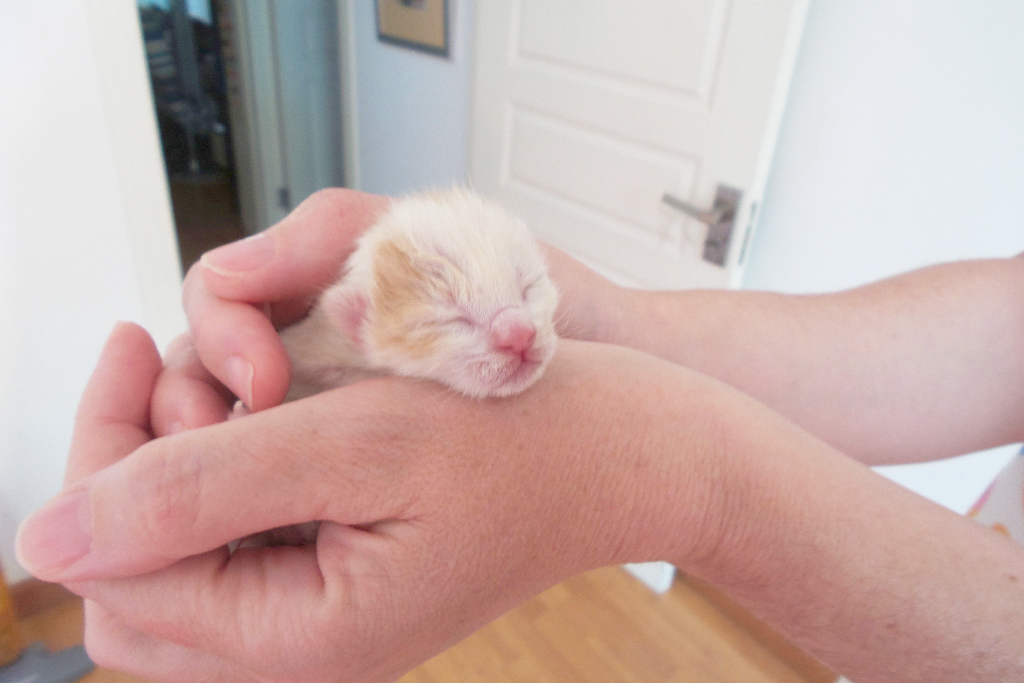
This is Reed on her first day out.
Taking Care of Kittens and Mom
After a normal birth, your new kittens should start to suckle. Your cat might wait until she has delivered all the babies before she allows them to suckle. If she ignores them and doesn’t let them nurse, or if they are trying to nurse but can’t get any milk, you can feed them the kitten formula with the kitten bottle. Then take the whole family to the vet to see if the vet can solve whatever your cat’s problem is.
If your cat eats up all the placentas, she will not be hungry, but if she doesn’t eat them, you might need to feed her some nutrient-rich food, such as egg yolk or liver, to help her keep her energy up during the delivery. Offer her water between deliveries, too. During the first day keep offering her food and water in her box, because she might not want to leave the kittens.
Some people say that if you touch a kitten, the mother cat will reject it. If your mother cat is comfortable with you, this is not true. She will have no problem with you helping and encouraging her during the birth. If you are fostering a feral cat or a lioness, though, you probably shouldn’t touch the kittens.
CONGRATULATIONS! You are now a kitty-grandma.
